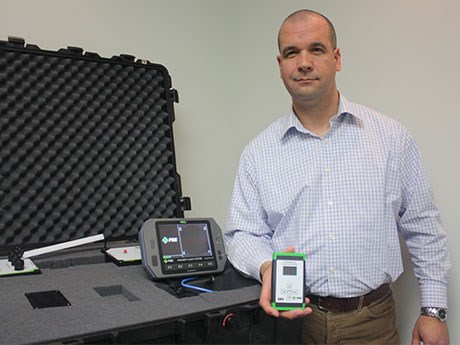System incorporates fi ve detection technologies
Many of the accidents and fatalities that happen in underground mining are caused by collisions between personnel and equipment.
However, with advancements in communication technology, productivity and safety are improving. The Pyott-Boone Electronics (PBE) Group recently introduced its Proximity Alert System (PAS) to mining companies around the world to address the interaction between workers and equipment. The system is customizable, combining five unique detection technologies into a single platform, including electromagnetic, global positioning system (GPS), radar, radio frequency identification (RFID) technology as well as cameras.
“The system heightens the operator’s situation awareness of personnel and vehicles,” said Joe Gladu, PBE’s general manager for Canada.
Gladu claims the Proximity Alert System is a game changing solution for proximity detection that solves vehicleto-vehicle, as well as vehicle-to-personnel interactions both in underground and surface mines.
The PBE Group was founded in 1971 by Frank Pyott and Roger Boone, who were leaders in the United States coal mining industry for technologically advanced communication and monitoring systems. Today, it is a global electronic engineering and manufacturing company serving the mining, tunneling, industrial and contract manufacturing industries. The company has offices with service and engineering support in seven countries.
In April 2011,The PBE Group was acquired by Prairie Capital and Vierville Capital, and Stuart Champion de Crespigny, the founder of Vierville Capital, became chief executive officer.
PBE acquired Australian-based Minecom, a manufacturer of underground communication systems, in March 2012, and subsequently purchased Mine Radio Systems (MRS) of Goodwood, Ontario, and the MineTracker solution developed by Four Leaf Solutions, a Sudbury company that went out of business in 2012.
The company specializes in communication and monitoring solutions, including personnel and vehicle tagging and tracking systems, atmospheric monitoring, equipment and vehicle telemetry, leaky feeder communication systems, conveyor belt monitoring, fire and dust suppression systems, and fan and pump monitoring.
It has grown from exclusively providing solutions to the United States coal mining industry to providing solutions that are common across the globe. Its office in Sudbury puts it close to its customer base in Northern Ontario.
“We have come up with a proximity awareness system that has five detection technologies because one size does not fit all,” said Gladu. “One technology may work in one situation, but not another because the reality is the operating conditions are very dynamic.”
Much like a reversing sensor that uses basic ultrasonic technology, the PAS uses electromagnetic technology and a touch screen user interface. Gladu explains that electromagnetic technology is really good at close range, which is great for the underground environment.
PAS is based on using active tags worn by miners underground for detection by sensors mounted on several spots on the vehicle. Detection range is adjustable from 60 to120 metres and will detect personnel around corners and blind spots, alerting the equipment operator through both audio and visual alerts.
“The operator will have a light bar that changes colour, so if a tag is in range it will show at each danger zone,” explains Gladu. “Each situation can be uniquely programmed and tuned for different vehicles and situations.”
The system is customizable for location and safety issues that are specific to the equipment and location of use. The screen on the vehicle dashboard also indicates the distance from the tagged personnel.
“For surface situations, we can use GPS with good accuracy,” said Gladu. “If you have a $5 million haul truck and an operator is unable to see due to weather conditions or a large hole on site, the GPS can address that situation. We can also use radar to bridge the gap across all of these technologies,” noted Gladu.
The majority of safety systems rely on cameras, but PBE sought feedback from its customers and learned that multiple technologies would provide the enhanced safety they required.
Incorporating the feedback, PBE engineers were able to design a system capable of accommodating multiple alert technologies. Customers also wanted a system that would reduce “cab clutter.”
The Proximity Alert System has been in operation for 15 months and has been commercially available since January with 15 systems now installed. For more information visit PBE’s YouTube demonstration http://goo.gl/HD96Cy



